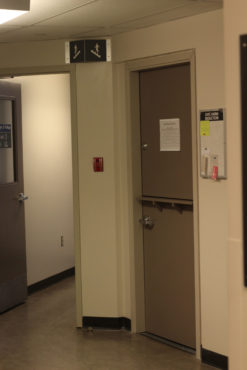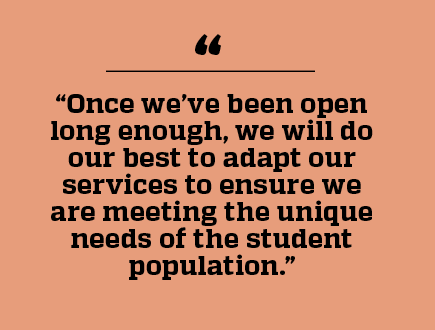
Coordinators say they chose the space because it was inconspicuous and accessible for students. Photo by Cormac O’Brien, Editor-in-Chief
If you’ve ever been in the basement of the SUB, you’ve probably walked past the Harm Reduction Centre (HRC) dozens of times without even realizing it. A small grey closet right across from Pride, the centre offers safer substance use resources, safer sex supplies, and information regarding the two. Opened in Nov. 2017, its co-ordinators — UVic Health Services, the UVSS, and Pride — are now encouraging students to use the resource by letting them know that it is there.
The HRC opened officially in November of last year after Pride, which had been providing students with similar services, learned they were no longer able to offer harm reduction in the SUB due to insurance considerations. However, with interest in harm reduction increasing due to the opioid crisis, Pride didn’t want to lose the resource for students.
They therefore approached university Health Services, which has appropriate insurance, to ensure the survival of the harm reduction services. Health Services accepted, and with the help of the UVSS, rented out a space in the basement of the SUB, where they have been since.

The Harm Reduction Centre, located at the bottom of the SUB stairwell. Photo by Cormac O’Brien, Editor-in-Chief
“I think that it’s sort of reducing one of the barriers to access [by being] in the SUB,” says Annie Lucas, one of the Registered Nurses working for Health Services. “It’s in a quiet space, it’s in the basement of the SUB, I think generally students feel better going there to get supplies rather than going to a clinic setting.”
Lucas says they also chose the SUB basement in order to be close to UVic Pride, where students were already going for resources. Health Services also wanted to continue to have Pride’s support, going so far as to coordinate the hours of operation with the Pride space for extra help, if needed.
UVic is one of the first university campuses in Canada to have a designated Harm Reduction Site. The centre is staffed by UVic volunteer students trained in harm reduction and overdose response. They provide supplies that encourage safer substance use, safer smoking, safer sex, safer injecting, and safer drug use, and some educational pamphlets provided by community harm reduction organizations like CATIE, AVI, CMHA, and Towards the Heart. Student volunteers also get co-curricular credit for volunteering.
“It’s a pretty relaxed environment. A lot of it simply involves answering questions about the HRC. Since we are so new on campus, students often walk by and have questions about what kind of services we offer,” says Riley Reel, a Registered Nurse and UVic student volunteer in charge of the day-to-day operations of the centre. “Once we’ve been open long enough, we will do our best to adapt our services to ensure we are meeting the unique needs of the student population.”
The student volunteers who work at the Centre are also trained in treating opioid overdoses. Health Services and UVSS offer naloxone training for anyone who is interested in learning about responding to an opioid overdose and obtaining a naloxone kit. Training takes place twice a month, and students can book an appointment at the Health Services Clinic to obtain a naloxone kit. For those who can’t make the training sessions, they can visit Towards the Heart’s website naloxonetraining.com to complete online training and take their certificate to any Take Home Naloxone Site to pick up a naloxone kit.
If students are curious about the HRC, Reel encourages them to swing by and say hi, if only to see where it is. Their hours are 12– 2 pm Monday to Friday, and they are planning on having the Centre open during the summer and with increased hours in the fall.
For now, the emphasis for Reel and UVic Health Services is promoting the centre’s existence.
“Some people that walk by the HRC still say that they did not know that UVic had a harm reduction centre, so my main goal right now is for us to advertise effectively to ensure that the HRC is being utilized as much as possible!” Reel says.
“So really, [our advertising efforts are] about the fact that it exists and that it’s open and it’s staffed by students but in partnership with student health,” says Rob Crisp, Director of UVic Health Services. “That whole collaborative piece is really important to me.”
If students are interested in volunteering at the centre, Crisp recommends they visit health.uvic.ca, and Reel recommends emailing lucasa@uvic.ca.
“It’s a great volunteer opportunity for students interested in gaining knowledge and experience related to harm reduction, as well as to easily accumulate volunteer hours for scholarships and resumes,” Reel says.
As the HRC is still relatively new, they are looking for feedback from any students who visit and use their services. Feedback can be provided at healthdir@uvic.ca.
For now, Lucas expresses gratitude to everyone who has made the HRC a reality.
“That collaboration — I think that’s been hugely important,” she says. “Pride, UVSS, volunteer students . . . I don’t know what the Harm Reduction Centre would’ve become without that collaboration.”
This article has been updated to correct the misspelled “healthdir@uvic.ca.” We apologize for the error.









